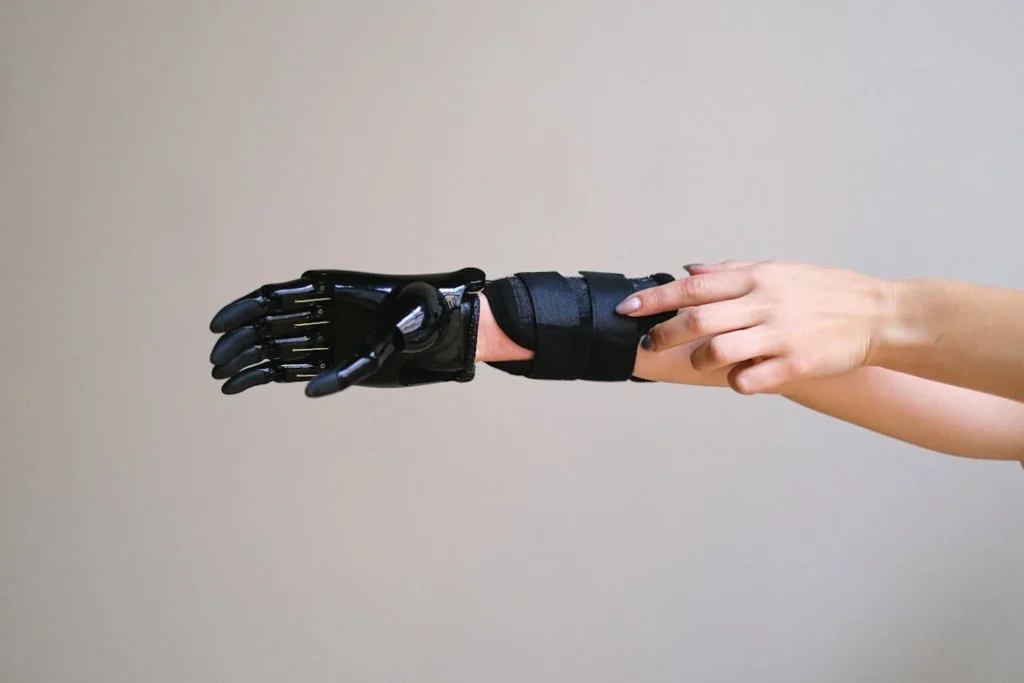Think about how often you use your hands without even noticing. Turning a doorknob. Holding a cup. Typing a message. Flipping a page. It’s not just about grasping things—it’s how we connect with the world. That’s why the ability to grip matters so much in upper-limb prosthetics. It’s not only about strength. It’s about control, flexibility, and feeling in tune with your hand.
Over the years, prosthetic hands have evolved from simple hooks and static shapes to advanced systems that mimic real fingers. Today’s biomechanical breakthroughs are changing what’s possible. They don’t just help someone hold an object—they help restore motion, independence, and confidence. The right grip lets a person get back to work, care for a child, or cook a favorite meal.
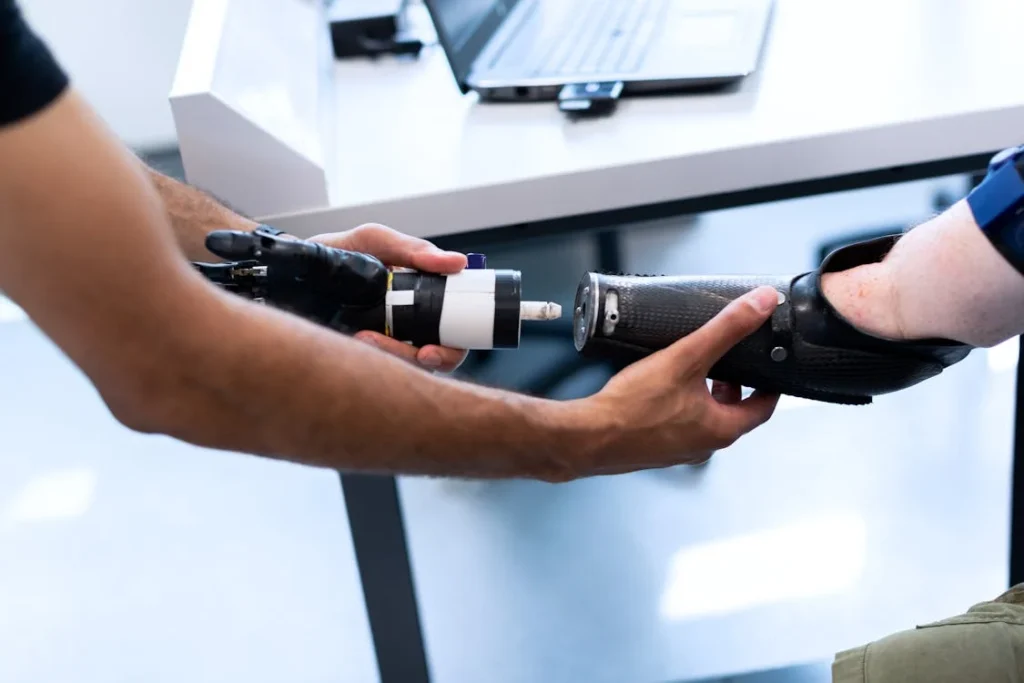
What Is a Functional Grip and Why Does It Matter?
Beyond Just Holding an Object
At first glance, a grip might seem simple. You close your hand around something and hold it. But in reality, a functional grip is much more than that. It’s about precision, timing, pressure, and feedback.
It’s about knowing how tightly to hold an egg without cracking it, or how to twist open a jar without dropping it.
In prosthetics, a functional grip means the user can perform everyday tasks with control and confidence.
This includes delicate movements, like picking up a coin or holding a pencil, as well as firm ones, like lifting a bag or turning a knob. The goal isn’t just to make the hand close—it’s to make it act naturally.
This is why a strong grip alone isn’t enough. The prosthetic must respond to different shapes, weights, and textures.
It must adjust quickly to how the object behaves in the hand. A functional grip is flexible and intelligent, not stiff or robotic.
How Our Natural Grip Works
In a natural hand, grip is controlled by a mix of bones, tendons, muscles, nerves, and skin. When you want to grab something, your brain sends a signal through the nerves to activate specific muscles.
These muscles pull tendons, which bend the fingers around the object.
But grip doesn’t stop there. As you hold something, your skin sends signals back to the brain. You feel how heavy or slippery it is.
If it starts to slip, your fingers react instantly by tightening just a bit more. This loop—between brain, nerves, muscles, and skin—is what gives our grip its fine control.
When designing a prosthetic hand, it’s hard to replicate this loop completely. But modern biomechanical systems try to get as close as possible.
They use sensors, motors, and smart software to read muscle signals and respond with fast, lifelike finger movement.
Grip Types and Their Importance
There isn’t just one type of grip. Our hands naturally shift between many kinds depending on what we’re doing. A “power grip” is used when holding heavy tools or bags.
A “pinch grip” comes into play when picking up a coin or writing. Then there’s the “tripod grip,” where the thumb, index, and middle fingers work together for tasks like holding a pen or spoon.
A well-designed prosthetic should allow the user to switch between these types. This is where newer biomechanical advances shine.
They let the user control individual fingers or preset grip patterns, giving them the ability to move through daily life without limits.
Having access to multiple grip types also reduces fatigue. The user doesn’t have to force one type of movement to do everything.
Instead, the hand adapts, just like a natural one would. That means fewer compensations from the shoulders or elbow, which helps with posture and comfort throughout the day.
Why Functional Grip Is Life-Changing
A prosthetic that offers a functional grip doesn’t just help someone “get by.” It helps them live more fully.
It means being able to shake hands without fear, cook a meal with ease, play a musical instrument, or button up a shirt without asking for help.
These moments may seem small, but they add up to independence. They help restore dignity and open doors that once felt closed.
For many users, gaining back the ability to grip something correctly is the beginning of getting their life back.
This is what drives innovation in prosthetics—not just making hands that move, but hands that feel useful, intuitive, and responsive. And with today’s biomechanical tools, we’re closer to that goal than ever.
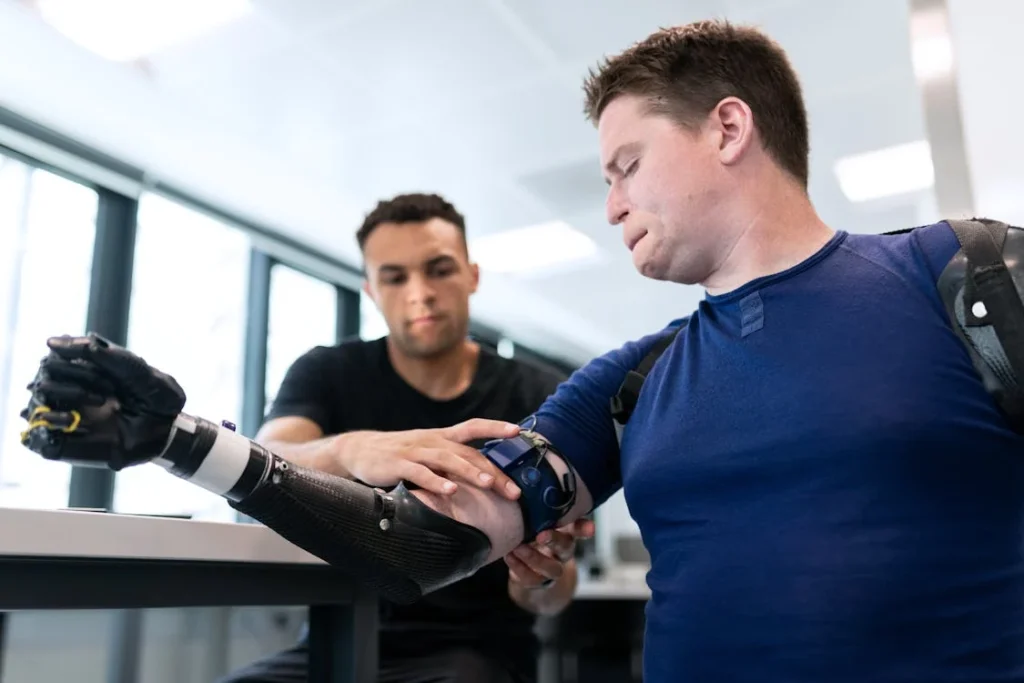
Biomechanics at Work: How Advanced Prosthetics Achieve Functional Grip
Muscle Signals and Myoelectric Control
One of the biggest steps forward in upper-limb prosthetics is myoelectric control. This system reads the tiny electrical signals made by muscles in the residual limb.
When the user thinks about closing their hand, those muscles contract slightly—even without a hand there. Myoelectric sensors pick up on this and turn the signal into movement in the prosthetic.
This makes control more intuitive. The user isn’t pushing a button or pulling a strap. They’re using the same muscles and thought process they always have.
The prosthetic becomes an extension of their will, not just a tool they operate.
In newer models, the control isn’t just on or off. The grip can tighten or relax based on how strong the muscle signal is.
This gives users more natural control over how firmly they hold something, whether it’s a pencil or a shopping bag.
Multi-Articulating Fingers and Grip Patterns
Earlier prosthetics had a simple claw or two-finger pinch. It worked for some tasks but felt limited. Today’s biomechanical hands often have fingers that can move independently or together in different patterns.
Some models use motors in each finger, allowing more flexibility in how the hand shapes itself around an object.
This gives users the ability to do more. They can choose a grip that matches the task—pinch, power, lateral, or open-hand.
These patterns can often be switched using muscle signals, smartphone apps, or automatic detection, depending on the system.
The result is a more human-like interaction with objects. Instead of forcing every task into one hand shape, the prosthetic adjusts. That makes everyday actions feel easier and more natural.
Adaptive Grip and Real-Time Feedback
In real hands, we adjust our grip based on feedback—whether the object is soft, hard, warm, cold, slippery, or heavy. Prosthetics are beginning to catch up with that idea.
Some advanced models now include pressure sensors in the fingers. These can detect when the object starts to slip or if the grip is too strong. The system then automatically adjusts the finger position or tightness to correct it.
Other systems use haptic feedback—vibrations or gentle pulses—sent to the arm or wrist to let the user know how much force they’re applying.
With practice, users begin to feel connected to the hand, almost as if it has sensation. This sense of “knowing” what the hand is doing is what turns gripping from a guess into something controlled.
In India, where prosthetic users may handle a wide range of daily tasks—from using hand pumps to gripping cooking utensils—this adaptive ability makes a big difference.
It helps reduce dropped objects, improves safety, and restores confidence.
Lightweight Design and Natural Motion
For a prosthetic to support a functional grip, it also has to be light enough for daily use. A bulky or heavy hand might offer power but can quickly lead to shoulder strain and fatigue.
Today’s biomechanical hands use lighter materials like carbon fiber, aircraft-grade aluminum, and high-impact polymers.
But lightness alone isn’t enough. The parts also have to move in ways that feel fluid. Advances in joint design and software control have helped improve finger motion.
The fingers now open and close in arcs that match natural hand movement, rather than in straight or awkward lines.
This smooth motion helps users better control how they approach objects. It also reduces the visual stiffness that can make prosthetic use feel unnatural in social settings.
When the hand moves more like a biological one, it builds confidence—not just in performance, but in how the user sees themselves.
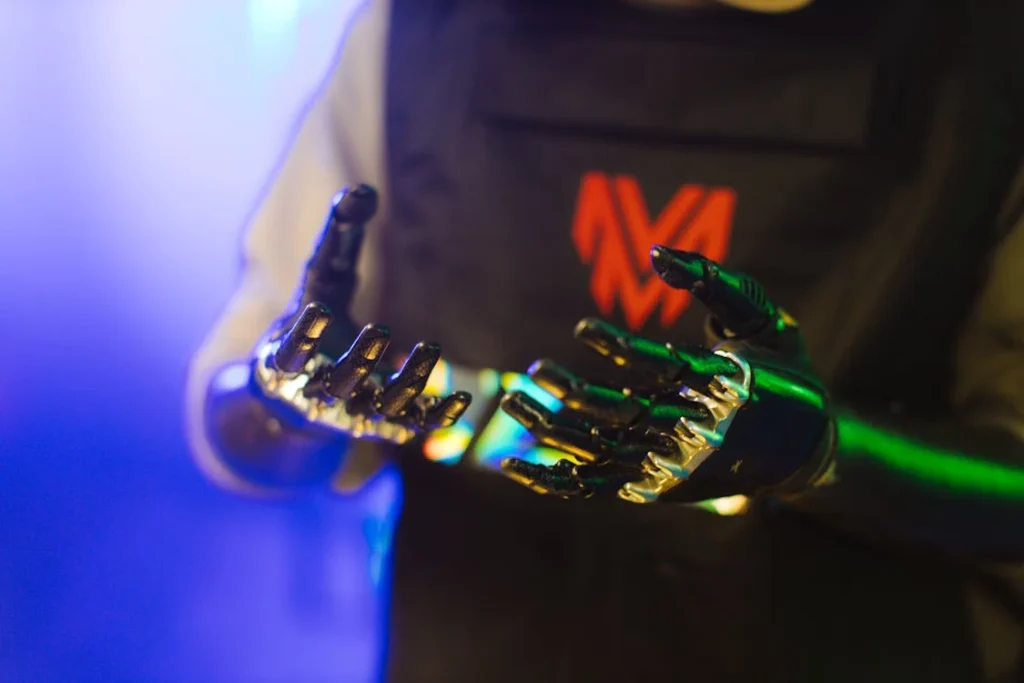
Real-Life Applications of Functional Grip in Everyday Life
Back to Work, Back to Productivity
For many people, using their hands isn’t just about daily living—it’s about livelihood. From typing on a computer to handling tools in workshops, the ability to grip with precision is essential.
In India, where many rely on hands-on work—tailoring, farming, mechanics, shopkeeping—a prosthetic with basic function won’t do the job.
Functional grip opens up opportunities. A person can write again, use a screwdriver, handle paper, or lift bags with confidence.
These tasks require a grip that can shift between gentle and firm, adjust to different shapes, and hold steady over time.
In workplaces, users often deal with tools and machines that don’t adjust to them. So, their prosthetic has to adapt instead.
With multi-pattern grips and responsive motors, modern prosthetic hands are making it possible for users to return to work not just as participants—but as skilled professionals.
Home and Family Life Becomes Easier
Home life is full of small tasks that demand hand function—cutting vegetables, changing gas cylinders, dressing children, folding clothes. Each of these actions requires a blend of grip, control, and movement.
With older prosthetics, users often had to ask for help or avoid certain tasks altogether. That created a sense of dependency.
But biomechanical hands with functional grips are changing that. A user can now hold a knife, pour tea, or help with household chores independently.
In the kitchen, where surfaces are often wet and items can be hot or fragile, a reliable grip reduces accidents. The ability to fine-tune grip pressure and angle means users don’t just work—they do so with care and precision.
This return to everyday action restores a rhythm of life that many users feared they had lost. It’s not about doing something “perfectly.” It’s about doing it confidently.
Supporting Social Interaction and Emotional Well-Being
Hands are more than tools—they’re part of how we connect. We shake hands, gesture, wave, and offer help with them.
For people with upper-limb loss, social interactions can feel more difficult when they worry about being seen as different or unable to respond naturally.
A functional grip that looks and moves like a real hand allows users to engage in social spaces without hesitation.
It means being able to greet someone with a firm handshake, pick up a cup at a wedding, or help a friend with a task. These small moments build social ease.
This emotional ease is powerful. It helps users shift from being self-conscious to feeling socially free. They become more involved, more expressive, and more connected to those around them.
Children and Students: Learning With Confidence
For children and students, school life involves constant hand use—writing, crafting, holding books, and using keyboards. With a limited or rigid prosthetic, these activities become frustrating or even impossible.
But when a child has a prosthetic that responds to their movement and gives them the grip they need, they can join in fully.
Writing becomes smoother, sports become doable, and group activities feel fun instead of fearful. It also makes a huge difference in classroom participation.
Children with functional prosthetics develop not only motor skills but also social ones. They gain confidence to speak up, share, and lead. That confidence spills into every part of life—helping them imagine futures with no limits.
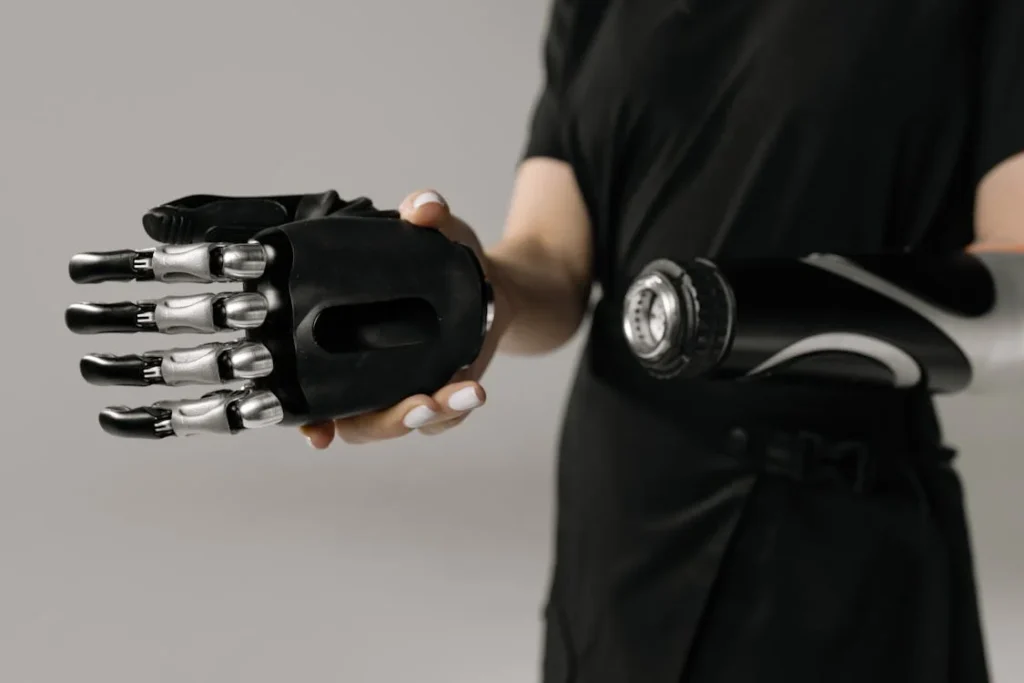
Personalization, Accessibility, and the Future of Functional Grip
No Two Users Are the Same
Even with all the technology in the world, a prosthetic only becomes powerful when it fits the person using it—not just physically, but in terms of lifestyle, personality, and goals.
Some people need a grip that can handle heavy tools. Others want one that can gently pick up a paintbrush. Each need is valid, and each grip must adapt.
That’s why personalization is key. Today’s biomechanical prosthetics can often be programmed to fit specific movements, preferred grip types, and even hand speeds.
Prosthetists can tune the hand to match the user’s strength, rhythm, and control style.
For example, someone who has strong residual muscle signals might want a more responsive hand, while another person might benefit from slower finger speeds and extra safety stops.
The ability to fine-tune these details means that one prosthetic model can be adapted to serve many different lives.
User Feedback Driving Smart Improvements
Users are no longer just recipients of prosthetics—they’re partners in shaping them. Real-world feedback from users is helping designers improve grip function in meaningful ways.
Maybe the finger needs to respond faster. Maybe the grip slips during certain tasks. Maybe a thumb angle feels unnatural.
This feedback loop has led to better grip shapes, more realistic hand posture, and improved control systems. The result? Hands that feel more alive and responsive.
Prosthetic developers are now working with users directly—through surveys, trials, and shared stories—to understand the full picture. This kind of co-creation brings solutions that are not only high-tech, but also deeply human.
In India, where daily life might include tasks that are culturally specific—like tying a sari, riding a bike, or carrying a tiffin—the feedback from local users is helping shape grip patterns that truly work in context.
3D Printing and Custom Fit
Thanks to technologies like 3D scanning and printing, it’s now possible to build a prosthetic that fits the exact shape of a person’s arm. This not only improves comfort but also enhances function.
When the socket fits better, the hand responds better. There’s less slippage, more stability, and greater control over the grip.
3D-printed elements can also include customized finger shapes, joint alignments, or support zones that match how the user interacts with objects.
In some cases, 3D-printed parts can be replaced more easily and affordably, allowing for quicker repairs or upgrades.
This is a huge win for accessibility, especially in countries where imports are costly or delays are long. Local clinics using these tools can deliver advanced, custom-fitted prosthetics faster and at lower costs.
Making Advanced Grip Technology Accessible
Perhaps the most important step forward is making all these features available to more people. Too often, the most advanced prosthetics are limited to large cities or high-end markets.
But functional grip is not a luxury—it’s a need. Everyone deserves the ability to hold, lift, carry, and create.
That’s why we at Robobionics focus on scalable, locally manufactured solutions. By designing systems that can be adjusted, repaired, and supported within India, we make sure that grip technology reaches those who need it—whether in a metro hospital or a rural workshop.
The goal is clear: bring the future of hand function to every person, in every setting, in a way that’s smart, sustainable, and truly supportive.
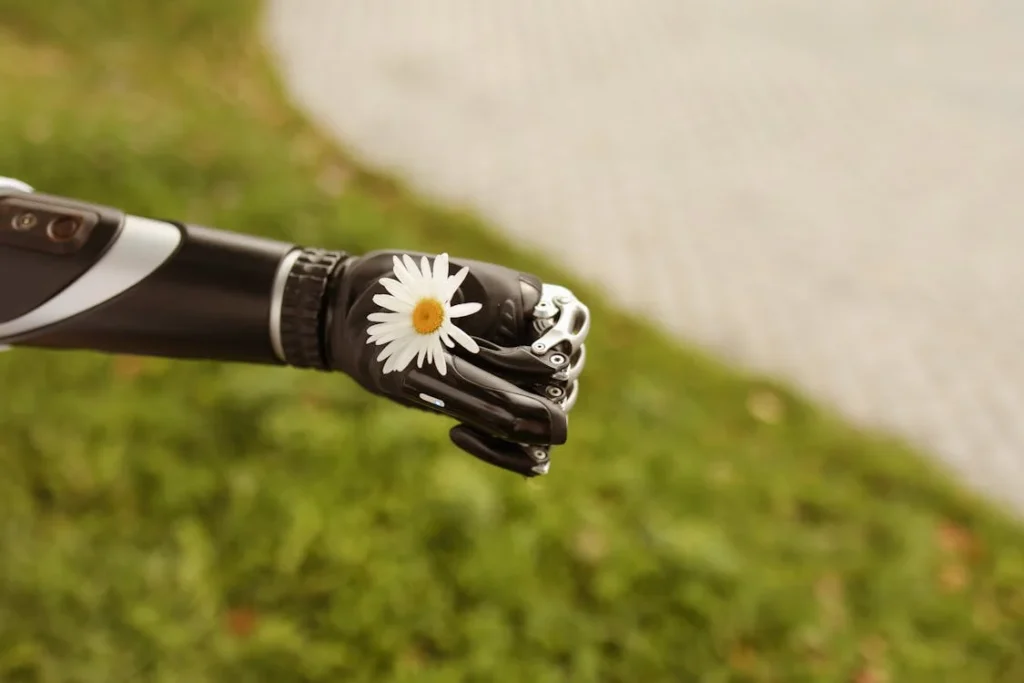
Cultural Touchpoints: Designing Grip for Human Connection and Expression
The Hand as a Tool of Culture
In many parts of the world, especially across South Asia, the hand is more than just a physical tool. It is deeply woven into everyday customs, greetings, rituals, and even communication.
Whether it’s folding your hands in a respectful “Namaste,” lighting a diya, feeding someone with the right hand, or offering a blessing with a simple touch—grip is about connection.
For someone using an upper-limb prosthetic, the ability to perform these culturally rooted gestures matters. It’s not just about being able to write or hold a cup.
It’s about expressing yourself in ways that feel familiar and respectful. It’s about being able to engage fully in community, faith, and family life.
A functional grip must take these details into account—not just the strength or type of hold, but the subtle movements that carry emotional and cultural meaning.
The Social Weight of a Simple Gesture
A handshake is more than a grip. It’s a first impression, a mark of equality, a signal of trust. In India, even more traditional greetings like the soft hand-touch during blessings or the handing over of Prasad in temples require gentle, nuanced movement.
If a prosthetic grip is too rigid or slow, these moments can become uncomfortable or even embarrassing. If it is designed with flexibility, responsiveness, and control, it brings dignity and ease to social exchanges.
The same goes for family interactions—lifting a baby, passing a bowl, or helping a loved one stand. These actions may seem simple, but they are emotionally rich. A prosthetic that enables them restores not only movement—but closeness.
Faith, Ceremony, and Personal Identity
Ceremonial actions often involve fine hand movements—holding incense, tying threads, offering flowers. In Hindu weddings, for instance, the act of giving or receiving gifts is symbolic. During prayer, even placing your hand in a certain way carries meaning.
Many users want to participate fully in these moments. They don’t want their prosthetic to hold them back during weddings, religious events, or even small daily rituals. This is where functional grip design meets cultural intelligence.
Designers and prosthetists must understand these needs to craft grips that aren’t just “strong,” but subtle, quiet, and graceful when needed. Movements that match the rhythm of the ritual, not interrupt it.
Gestures in Communication and Expression
In daily conversation, gestures help us speak. We use our hands to explain, emphasize, joke, and show emotion. In classrooms, in meetings, and around the dinner table, a wave, a point, or even a relaxed open-hand posture helps people engage.
A prosthetic with a natural-looking grip that can hold poses comfortably or respond fluidly helps users communicate with confidence.
It allows them to be seen not just as functional, but expressive and fully present in the room.
This kind of presence matters deeply. It lets people be more than their condition—it lets them be themselves.
Designing with Culture in Mind
Too often, prosthetic design comes from a clinical or industrial mindset. But real human lives don’t work in labs.
They work in temples, kitchens, bus stops, and prayer halls. They unfold in moments of joy, grief, gratitude, and celebration. That’s where grip truly lives.
At Robobionics, we believe that biomechanical design should start with empathy. It should ask: What does this user need to hold, not just physically—but socially and emotionally?
When grip design meets cultural understanding, it doesn’t just restore function—it restores belonging.
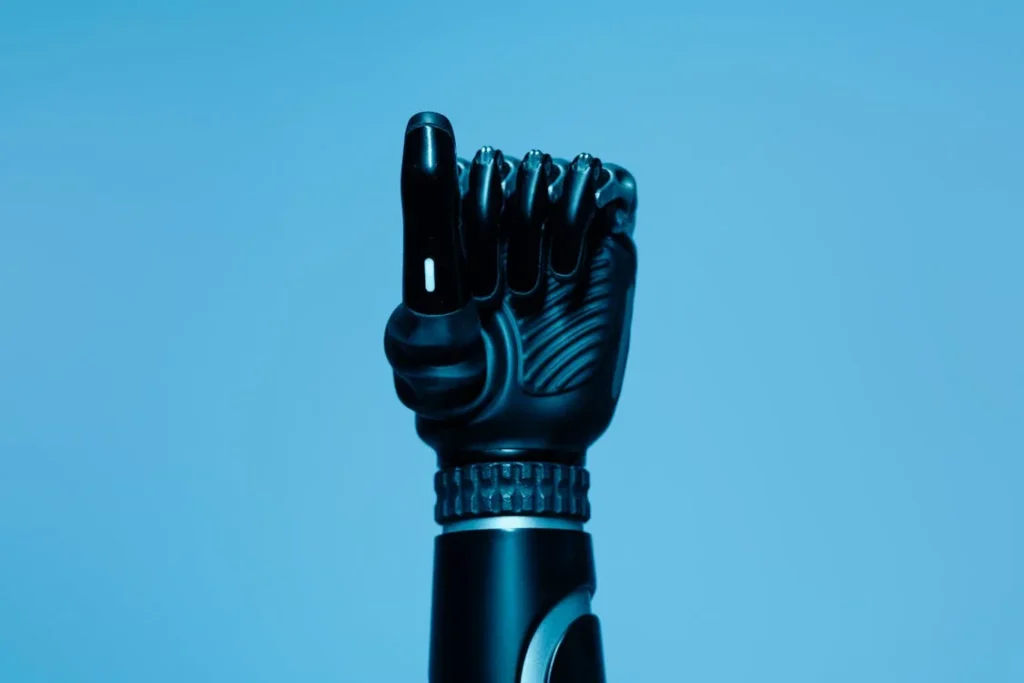
The Mind Behind the Movement: Reducing Mental Load Through Smarter Grip Control
Every Movement Starts in the Brain
Before the hand even moves, the brain is already working. It decides how hard to grip, which fingers to use, how fast to move, and when to release. In a natural hand, this process is automatic.
You don’t think about gripping a glass—you just do it. But with a prosthetic, especially one that requires manual control or unnatural movement patterns, this mental process becomes conscious.
Users have to think about how to move the hand. They must remember what each signal does, how to time it, and whether their grip is strong enough.
That creates cognitive load—the mental energy needed to carry out a physical task. Over time, this becomes tiring, frustrating, and emotionally draining.
The Hidden Cost of Poor Grip Design
When a prosthetic hand doesn’t respond well—or if it requires unnatural gestures or buttons to work—it takes longer to complete simple tasks.
That delay might be a few seconds here and there, but it adds up. Each small action becomes an obstacle.
This kind of stop-start movement interrupts the natural flow of life. It’s not just about time—it’s about brainpower.
When someone has to focus on how to grab a spoon instead of what they’re doing with it, they’re using extra energy. That energy could be better spent enjoying the moment or engaging socially.
This can lead to fatigue—not just in the body, but in the mind. Users may avoid using the prosthetic altogether in certain situations, simply to avoid the hassle.
Smarter, More Intuitive Grip Reduces Friction
The most successful upper-limb prosthetics are the ones that reduce mental effort. They make grip feel natural and automatic.
This is where intuitive control systems, like myoelectric sensors and gesture-based switching, make a real difference.
Instead of memorizing sequences or controlling each finger manually, users can simply contract a muscle or move in a familiar way.
The hand responds. It feels less like controlling a machine and more like using a part of their body. That shift—from conscious control to intuitive flow—is a game-changer.
When users don’t have to “think” every time they move, they start to re-engage with the world more fully. They move faster, feel less frustration, and gain more confidence.
The prosthetic disappears into the background, which is exactly where it belongs.
How Emotional Energy Comes Into Play
Mental energy and emotional energy are deeply connected. When every action with a prosthetic is a small challenge, it slowly chips away at motivation.
Users start to avoid certain tasks, social events, or even creative activities they once enjoyed.
But when the grip responds naturally—when the hand feels like it knows what to do—it lifts that emotional weight. It restores joy in doing things independently.
It brings back spontaneity. People cook without rehearsing every step. They paint, play, or type without checking if the hand will “cooperate.”
It also helps users feel more in control of their identity. When the prosthetic hand becomes something they can trust, it shifts the emotional relationship from dependency to empowerment.
Designing for the Mind, Not Just the Hand
This is the next frontier in prosthetic innovation—creating systems that think with the user, not just for the user. Hands that respond to intention, that don’t force people to fight their way through simple motions.
Grip systems that work with the brain, not against it.
At Robobionics, we understand that functional grip isn’t just about moving fingers. It’s about freeing the mind. When users don’t have to think so hard just to hold a pen, a spoon, or someone’s hand—they can think about everything else that makes life meaningful.
Conclusion
Biomechanical advances in upper-limb prosthetics have redefined what it means to grip. Today, it’s not just about closing a hand—it’s about responding, adapting, and living without limits. A functional grip means holding a tool at work, serving tea to family, or simply feeling at ease during a handshake.
With smart sensors, intuitive control, and culturally aware design, prosthetic grip is becoming more personal, more natural, and more empowering. It reduces mental effort, restores emotional ease, and helps users reconnect with life—on their terms.
At Robobionics, we believe every hand should move with purpose and every person should feel confident in their ability to create, connect, and express. That’s why we continue to build prosthetics that don’t just restore motion, but restore identity.



